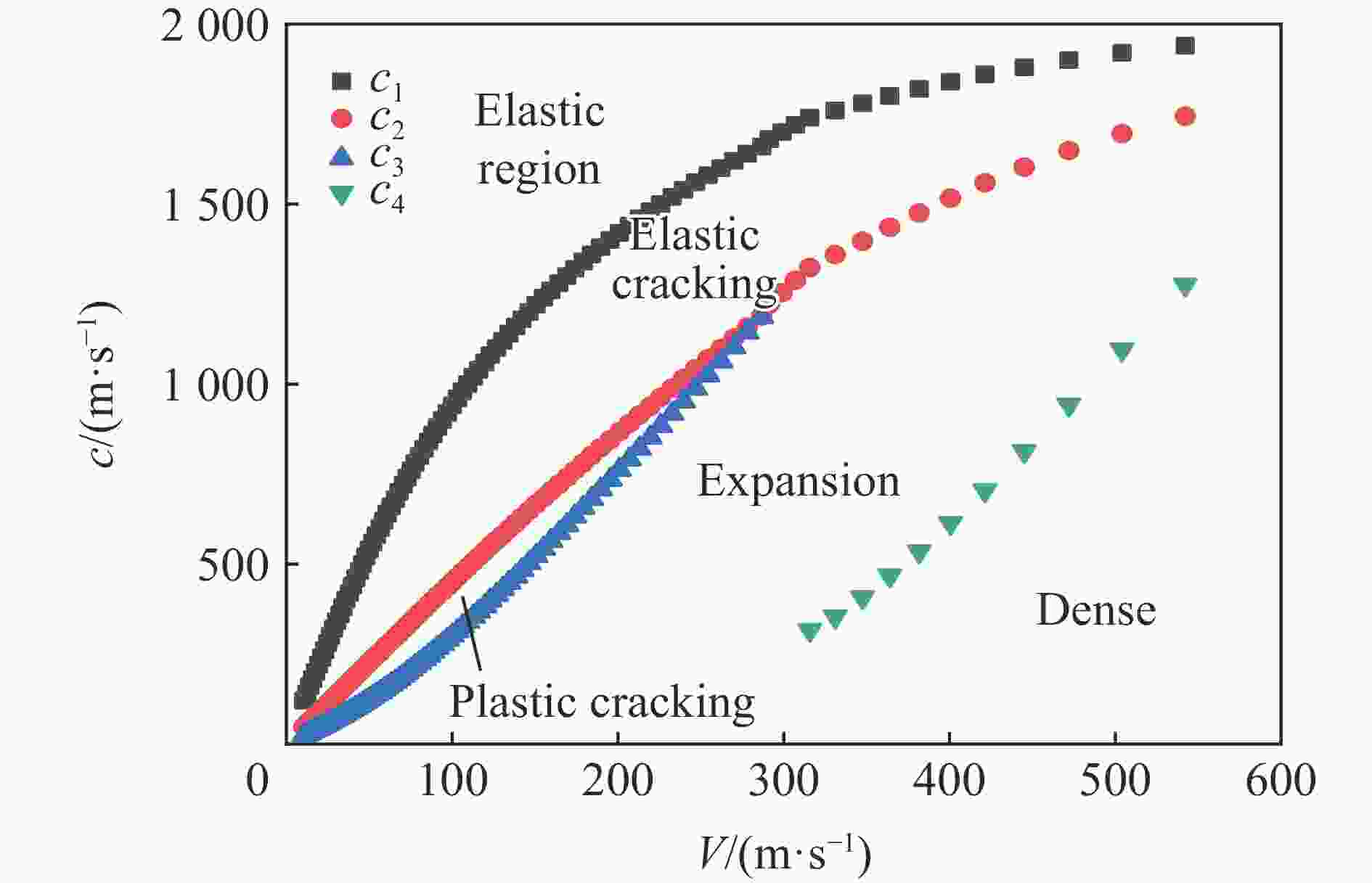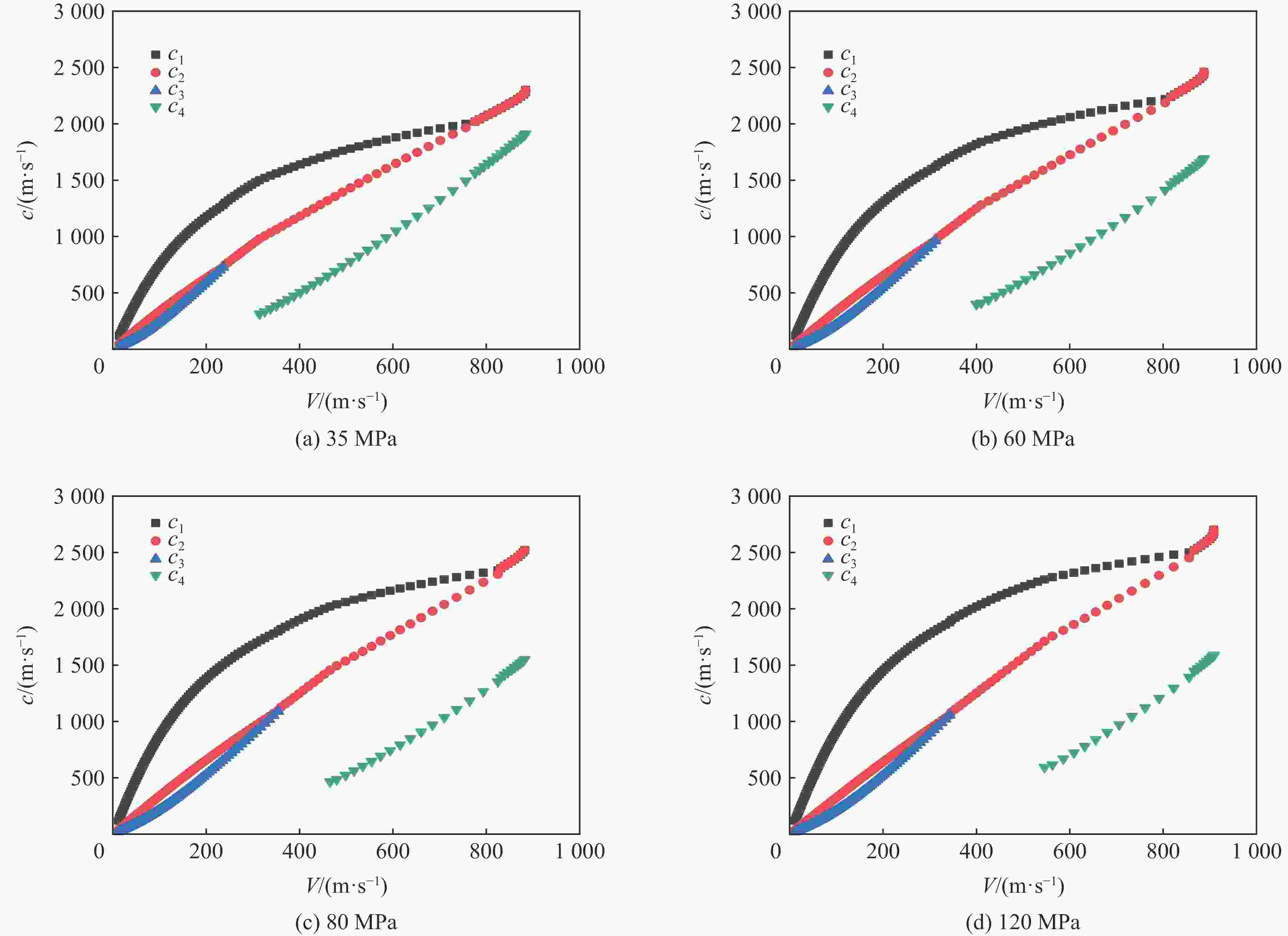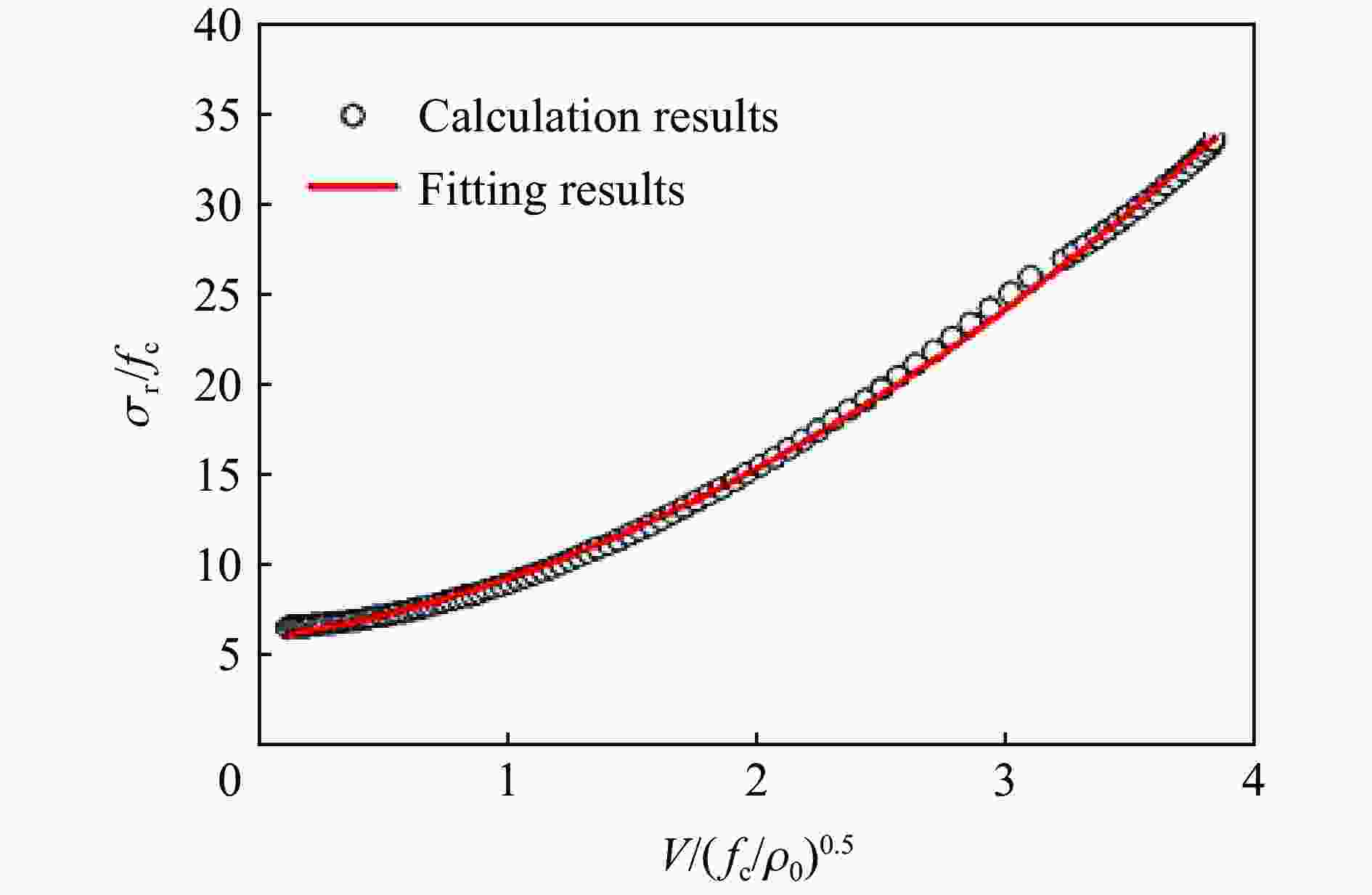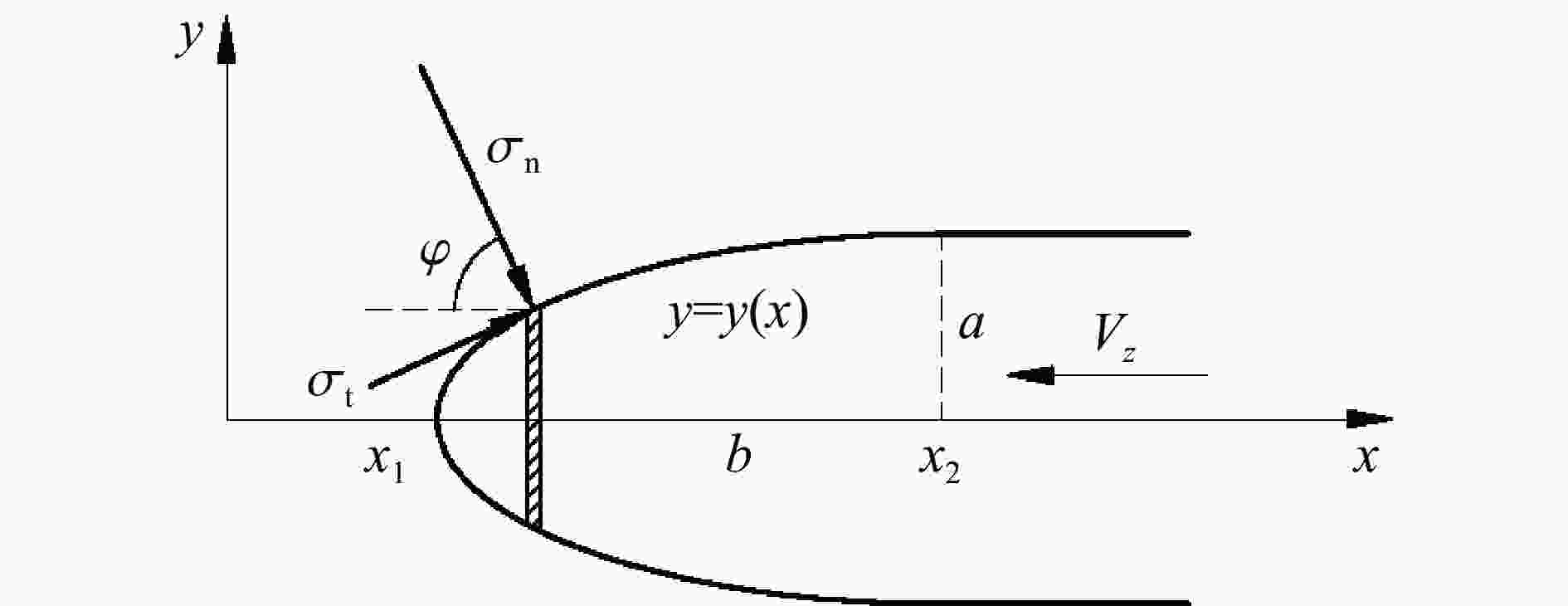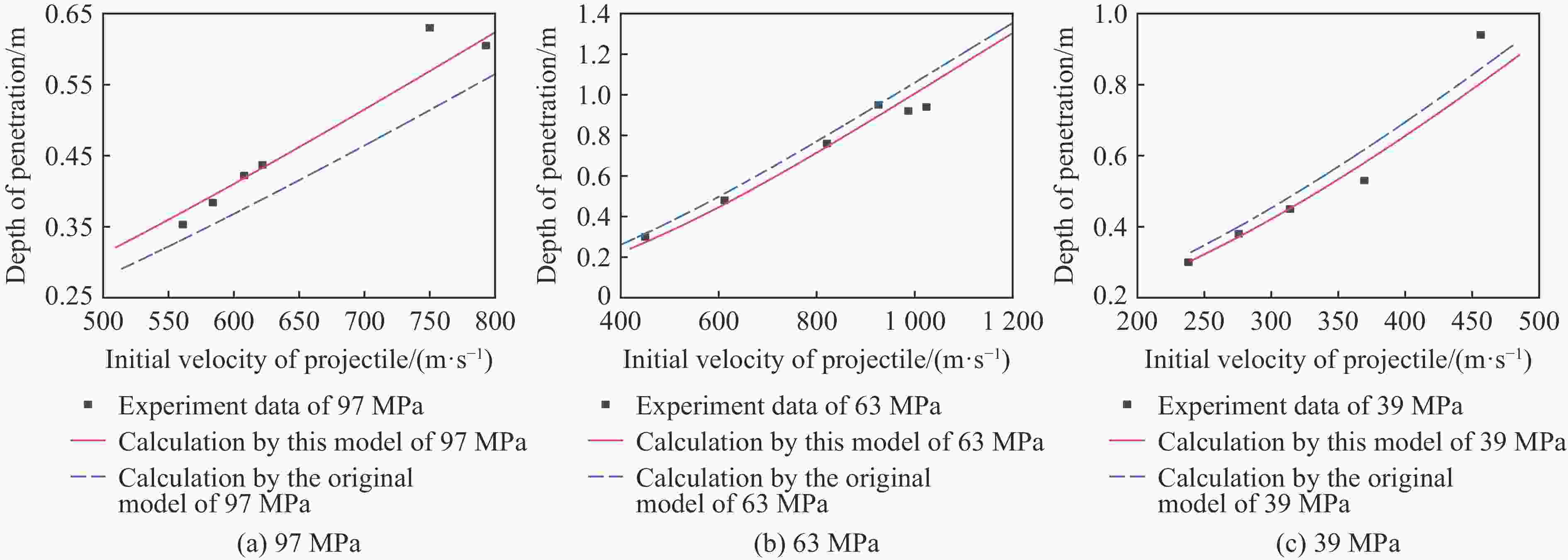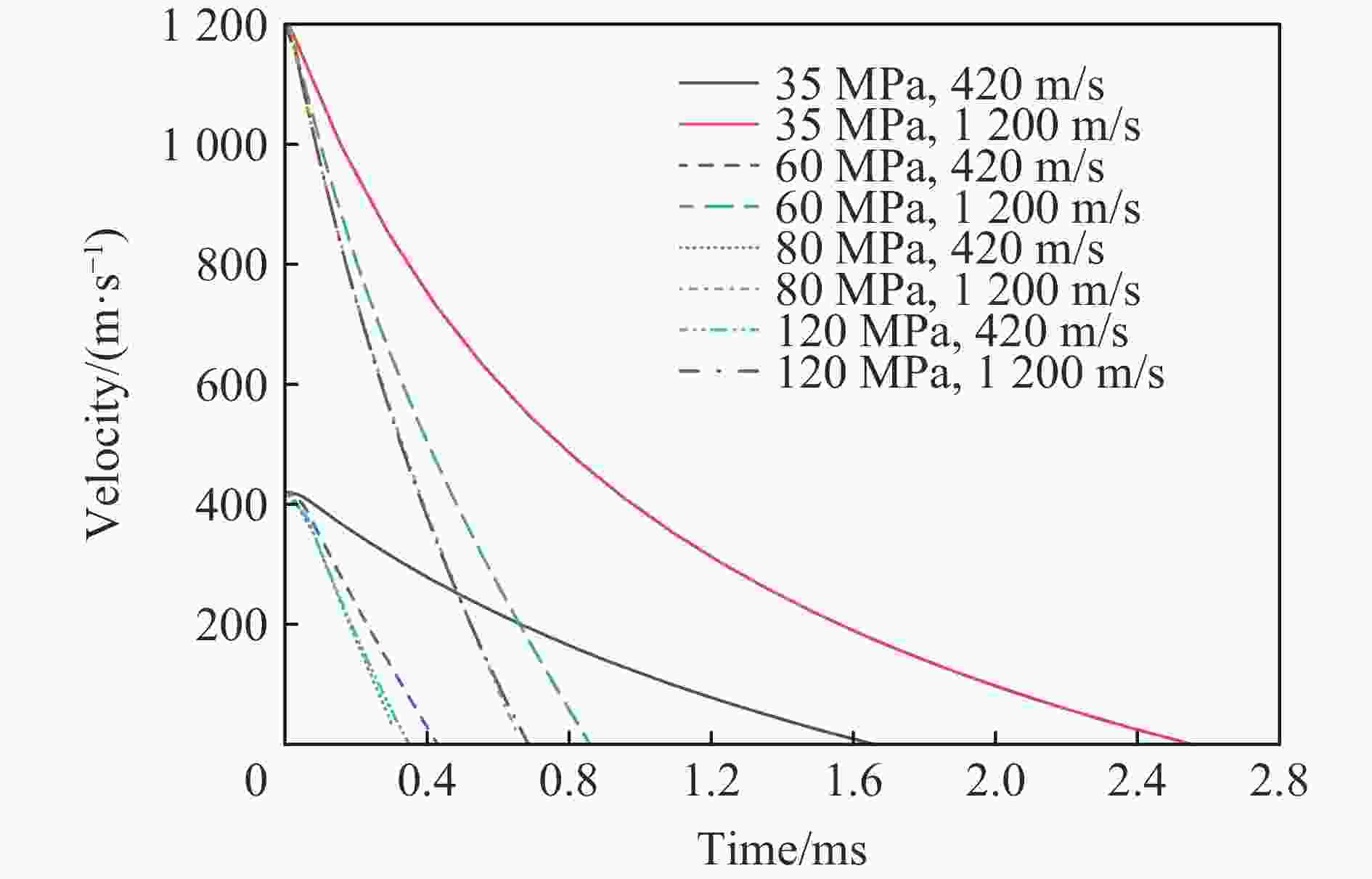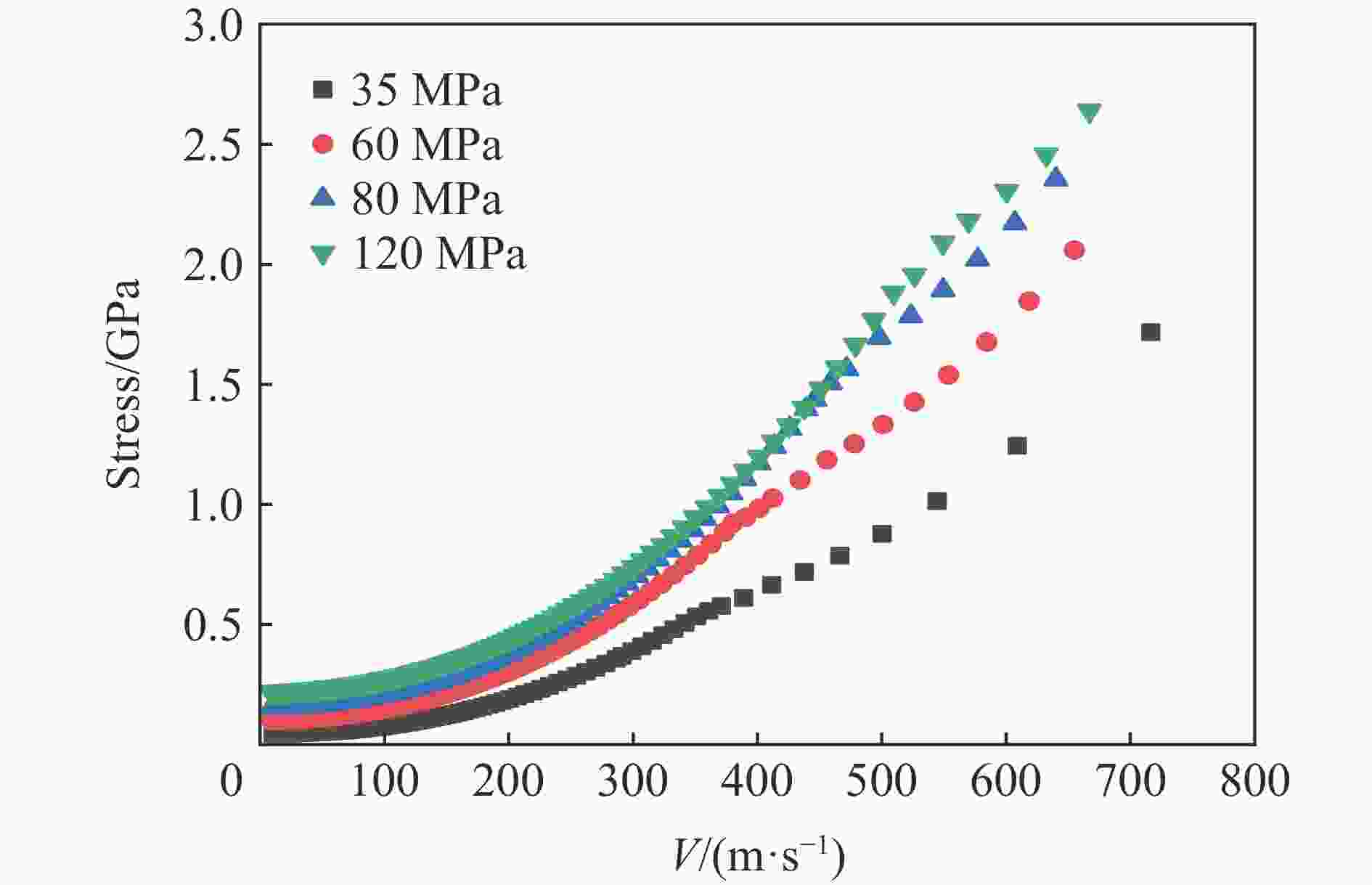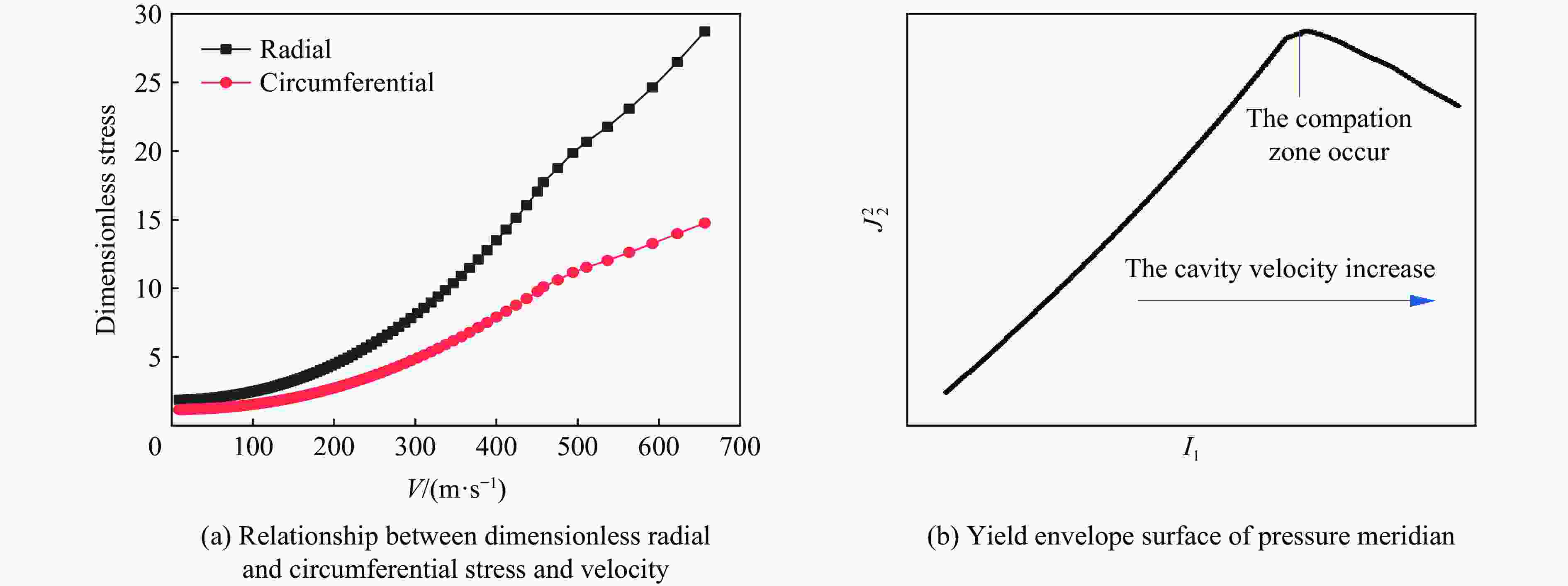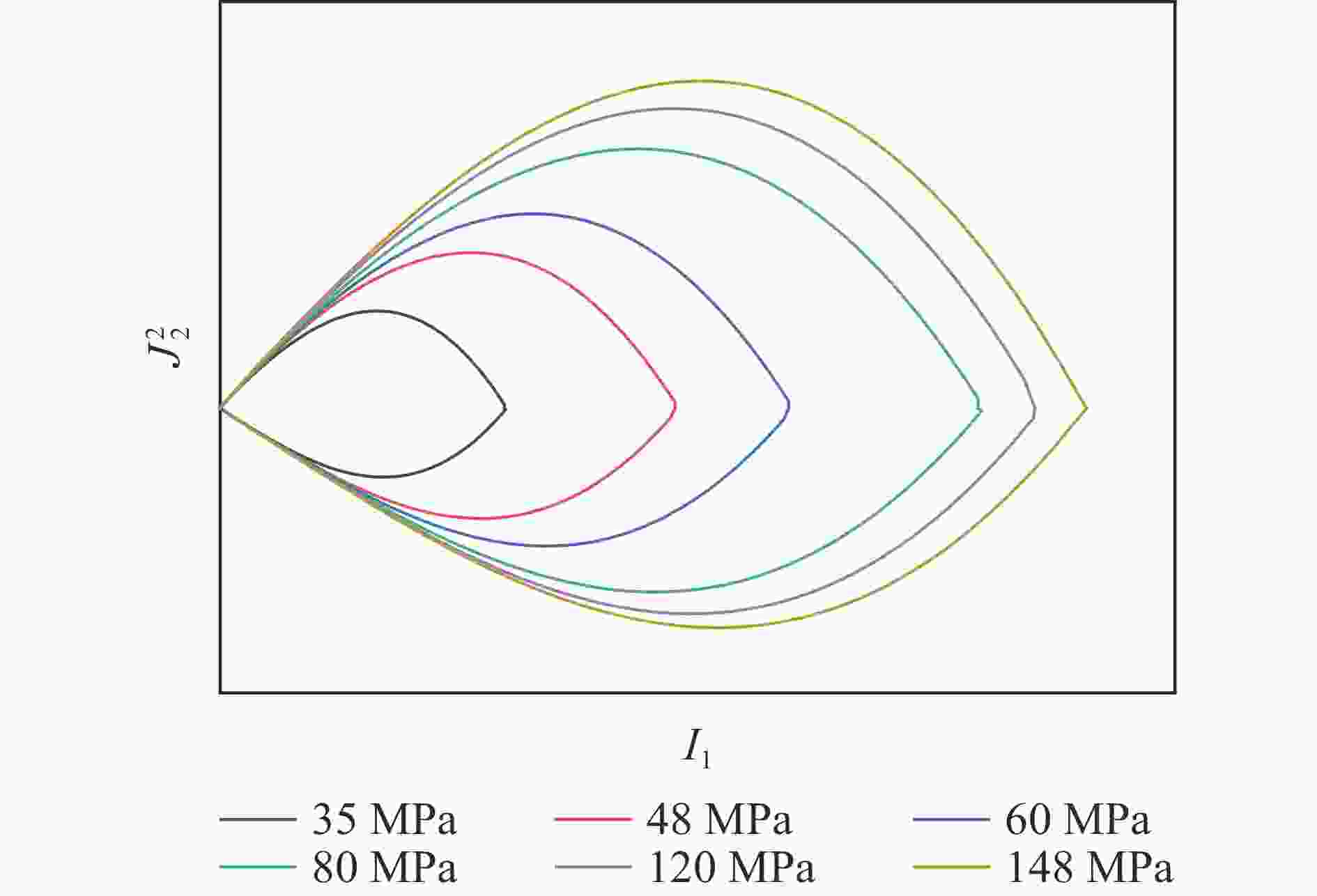Cavity expansion model and penetration mechanism of concrete with different strengths based on the Ottosen yield condition
-
摘要: 针对毁伤与防护领域对深层超硬目标理论研究及工程应用的迫切需求,引入改进的Ottosen屈服条件,对混凝土空腔膨胀过程中的响应分区和边界条件进行优化,求解空腔膨胀的全过程,分析不同强度混凝土响应分区的变化规律;根据空腔边界应力和空腔膨胀速度的关系,建立了弹体侵彻深度计算模型,对弹体侵彻不同强度混凝土工况进行了对比计算,并深入分析了靶体强度对侵彻深度影响的机理。通过与实验数据进行对比发现,改进的空腔膨胀理论对于普通混凝土和高强混凝土均有很好的适用性,可准确计算径向应力与空腔边界速度关系以及侵彻深度。研究结果显示,高强混凝土的弹塑性开裂区范围更大,密实区范围更小,表明了高强混凝土脆性大,材质密实的特点,引入塑性开裂区可以更好地反应侵彻过程中高强混凝土压实时对应速度更高的现象;随着混凝土强度的提高,其屈服包络面变化越来越小,因此混凝土的空腔边界应力增大但变化程度越来越小,导致弹体侵彻深度随速度增加的增量变小。
-
关键词:
- Ottosen屈服条件 /
- 空腔膨胀理论 /
- 高强混凝土 /
- 侵彻深度
Abstract: Aiming at the urgent demand for theoretical research and engineering application of deep super hard targets in the field of damage and protection, the response zone and boundary conditions during the cavity expansding process are optimized in this paper based on the improved Ottosen yield condition. The entire process of cavity expansion is solved, the changes in the response zone of concrete with different strengths are analyzed. According to the relationship between cavity boundary stress and cavity expansion velocity, a calculation model of projectile penetration depth is established, and the penetration depth of projectile penetration into concrete with different strengths are calculated. The mechanism of the influence of target strength on penetration depth is also analyzed. The results show that the elastic and plastic cracking zone of high-strength concrete is larger and the compacted zone is smaller, indicating that high-strength concrete is more brittle and compact. And the addition of plastic cracking zone can better reflect the phenomenon of concrete with different strengths in penetration. By comparing with the experimental data, it can be seen that the cavity expansion theory established in this paper has good applicability for normal concrete and high-strength concrete. The relationship between radial stress and cavity boundary velocity and the penetration depth also can be accurately calculated by this theory. With the increase of concrete strength, the difference in the cavity boundary stress of the concrete becomes smaller, resulting in a smaller increase in the penetration depth of the projectile as the velocity increases, and the penetration depth of the projectile decreases and gradually tends to a certain value at the same speed. -
表 1 不同抗压强度混凝土的力学性能参数
Table 1. Mechanical properties of concrete with different compressive strength
表 2 不同强度混凝土的力学性能参数
Table 2. Mechanical property parameters of concrete with different strengths
抗压强度/MPa 密度/(kg·m−3) 弹性模量/GPa 泊松比 拉压比 屈服强度/MPa 扩容时强度/MPa 39 2400 29.2 0.2 0.075 9.2 37.3 63 2420 34.8 0.2 0.061 18.6 60.9 97 2520 39.8 0.2 0.049 29.7 94.8 -
[1] FORRESTAL M J, TZOU D Y. A spherical cavity-expansion penetration model for concrete targets [J]. International Journal of Solids and Structures, 1997, 34(31/32): 4127–4146. DOI: 10.1016/S0020-7683(97)00017-6. [2] FORRESTAL M J, LUK V K. Dynamic spherical cavity-expansion in a compressible elastic-plastic solid [J]. Journal of Applied Mechanics, 1988, 55(2): 275–279. DOI: 10.1115/1.3173672. [3] 黄民荣, 顾晓辉, 高永宏. 脆性材料静态抗侵彻阻力简化计算模型与对比研究 [J]. 弹道学报, 2009, 21(2): 86–89.HUANG M R, GU X H, GAO Y H. Simplified analytical model and its contrast study on the static penetration resistance of brittle materials [J]. Journal of Ballistics, 2009, 21(2): 86–89. [4] 黄民荣, 顾晓辉, 高永宏. 基于Griffith强度理论的空腔膨胀模型与应用研究 [J]. 力学与实践, 2009, 31(5): 30–34. DOI: 10.6052/1000-0879-2008-351.HUANG M R, GU X H, GAO Y H. Cavity expansion model based on the Griffith strength theory and its application [J]. Mechanics in Engineering, 2009, 31(5): 30–34. DOI: 10.6052/1000-0879-2008-351. [5] ZHANG S, WU H J, TAN Z J, et al. Theoretical analysis of dynamic spherical cavity expansion in reinforced concretes [J]. Key Engineering Materials, 2016, 715: 222–227. DOI: 10.4028/www.scientific.net/KEM.715.222. [6] 曹扬悦也, 蒋志刚, 谭清华, 等. 基于Hoek-Brown准则的混凝土-岩石类靶侵彻模型 [J]. 振动与冲击, 2017, 36(5): 48–53, 60. DOI: 10.13465/j.cnki.jvs.2017.05.008.CAO Y Y Y, JIANG Z G, TAN Q H, et al. Penetration model for concrete-rock targets based on Hoek-Brown criterion [J]. Journal of Vibration and Shock, 2017, 36(5): 48–53, 60. DOI: 10.13465/j.cnki.jvs.2017.05.008. [7] 詹昊雯, 曹扬悦也, 蒋志刚, 等. 约束混凝土靶的准静态柱形空腔膨胀理论 [J]. 弹道学报, 2017, 29(2): 13–18.ZHAN H W, CAO Y Y Y, JIANG Z G, et al. Quasi-static cylindrical cavity-expansion model for confined-concrete targets [J]. Journal of Ballistics, 2017, 29(2): 13–18. [8] XU H, WEN H M. A spherical cavity expansion penetration model for concrete based on Hoek-Brown strength criterion [J]. International Journal of Nonlinear Sciences and Numerical Simulation, 2012, 13(2): 145–152. DOI: 10.1515/ijnsns-2011-099. [9] FENG J, LI W B, WANG X M, et al. Dynamic spherical cavity expansion analysis of rate-dependent concrete material with scale effect [J]. International Journal of Impact Engineering, 2015, 84: 24–37. DOI: 10.1016/j.ijimpeng.2015.05.005. [10] SATAPATHY S. Dynamic spherical cavity expansion in brittle ceramics [J]. International Journal of Solids and Structures, 2001, 38(32/33): 5833–5845. DOI: 10.1016/S0020-7683(00)00388-7. [11] 李志康, 黄风雷. 高速长杆弹侵彻半无限混凝土靶的理论分析 [J]. 北京理工大学学报, 2010, 30(1): 10–13. DOI: 10.15918/j.tbit1001-0645.2010.01.002.LI Z K, HUANG F L. High velocity long rod projectile’s penetration into semi-infinite concrete targets [J]. Transactions of Beijing Institute of Technology, 2010, 30(1): 10–13. DOI: 10.15918/j.tbit1001-0645.2010.01.002. [12] 李志康. 弹体正侵彻半无限混凝土靶的理论分析 [D]. 北京: 北京理工大学, 2008. [13] 王一楠. 动能弹体高速侵彻混凝土机理研究 [D]. 北京: 北京理工大学, 2009. [14] 何涛. 动能弹在不同材料靶体中的侵彻行为研究 [D]. 合肥: 中国科学技术大学, 2007.HE T. A study on the penetration of projectiles into targets made of various materials [D]. Hefei: University of Science and Technology of China, 2007. [15] HE T, WEN H M, GUO X J. A spherical cavity expansion model for penetration of ogival-nosed projectiles into concrete targets with shear-dilatancy [J]. Acta Mechanica Sinica, 2011, 27(6): 1001–1012. DOI: 10.1007/s10409-011-0505-1. [16] 张欣欣, 闫雷, 武海军, 等. 考虑剪胀效应的混凝土动态球形空腔膨胀理论 [J]. 兵工学报, 2016, 37(1): 42–49. DOI: 10.3969/j.issn.1000-1093.2016.01.007.ZHANG X X, YAN L, WU H J, et al. A note on the dynamic spherical cavity expansion of concrete with shear dilatancy [J]. Acta Armamentarii, 2016, 37(1): 42–49. DOI: 10.3969/j.issn.1000-1093.2016.01.007. [17] ZHANG X Y, WU H J, LI J Z, et al. A constitutive model of concrete based on Ottosen yield criterion [J]. International Journal of Solids and Structures, 2020, 193/194: 79–89. DOI: 10.1016/j.ijsolstr.2020.02.013. [18] OTTOSEN N S. A failure criterion for concrete [J]. Journal of Engineering Mechanics Division, 1997, 103(4): 527–535. [19] 过镇海. 混凝土的强度和变形-试验基础和本构关系 [M]. 北京: 清华大学出版社, 1997. [20] ČERVENKA J, PAPANIKOLAOU V K. Three dimensional combined fracture-plastic material model for concrete [J]. International Journal of Plasticity, 2008, 24(12): 2192–2220. DOI: 10.1016/j.ijplas.2008.01.004. [21] PAPANIKOLAOU V K, KAPPOS A J. Confinement-sensitive plasticity constitutive model for concrete in triaxial compression [J]. International Journal of Solids and Structures, 2007, 44(21): 7021–7048. DOI: 10.1016/j.ijsolstr.2007.03.022. [22] ARÁOZ G, LUCCIONI B. Modeling concrete like materials under sever dynamic pressures [J]. International Journal of Impact Engineering, 2015, 76: 139–154. DOI: 10.1016/j.ijimpeng.2014.09.009. [23] DAHL K K B. A constitutive model for normal and high strength concrete [R]. Anker Engelunds Vej: Technical University of Denmark, 1992. [24] KUPFER H, HILSDORF K H, RUSH H. Behavior of concrete under biaxial stresses [J]. Journal of the Engineering Mechanics Division Asce, 1969, 99(8): 656–666. DOI: 10.14359/7388. [25] IMRAN I, PANTAZOPOULOU S J. Plasticity model for concrete under triaxial compression[J]. Journal of Engineering Mechanics, 2001, 127(3): 281–290. DOI: 10.1061/(ASCE)0733-9399(2001)127:3(281). [26] GABET T, MALÉCOT Y, DAUDEVILLE L. Triaxial behaviour of concrete under high stresses: influence of the loading path on compaction and limit states [J]. Cement and Concrete Research, 2008, 38(3): 403–412. DOI: 10.1016/j.cemconres.2007.09.029. [27] VU X H, MALECOT Y, DAUDEVILLE L, et al. Experimental analysis of concrete behavior under high confinement: Effect of the saturation ratio [J]. International Journal of Solids and Structures, 2009, 46(5): 1105–1120. DOI: 10.1016/j.ijsolstr.2008.10.015. [28] FORRESTAL M J, ALTMAN B S, CARGILE J D, et al. An empirical equation for penetration depth of ogive-nose projectiles into concrete targets [J]. International Journal of Impact Engineering, 1994, 15(4): 395–405. DOI: 10.1016/0734-743X(94)80024-4. [29] FORRESTAL M J, FREW D J, HANCHAK S J, et al. Penetration of grout and concrete targets with ogive-nose steel projectiles [J]. International Journal of Impact Engineering, 1996, 18(5): 465–476. DOI: 10.1016/0734-743X(95)00048-F. [30] FORRESTAL M J, FREW D J, HICKERSON J P, et al. Penetration of concrete targets with deceleration-time measurements [J]. International Journal of Impact Engineering, 2003, 28(5): 479–497. DOI: 10.1016/S0734-743X(02)00108-2. [31] 武海军, 黄风雷, 王一楠, 等. 高速侵彻混凝土弹体头部侵蚀终点效应实验研究 [J]. 兵工学报, 2012, 33(1): 48–55.WU H J, HUANG F L, WANG Y N, et al. Experimental investigation on projectile nose eroding effect of high-velocity penetration into concrete [J]. Acta Armamentarii, 2012, 33(1): 48–55. [32] 张雪岩, 武海军, 李金柱, 等. 弹体高速侵彻两种强度混凝土靶的对比研究 [J]. 兵工学报, 2019, 40(2): 276–283. DOI: 10.3969/j.issn.1000-1093.2019.02.007.ZHANG X Y, WU H J, LI J Z, et al. Comparative study of projectiles penetrating into two kinds of concrete targets at high velocity [J]. Acta Armamentarii, 2019, 40(2): 276–283. DOI: 10.3969/j.issn.1000-1093.2019.02.007. [33] WU H, FANG Q, CHEN X W, et al. Projectile penetration of ultra-high performance cement based composites at 510-1320m/s [J]. Construction and Building Materials, 2015, 74: 188–200. DOI: 10.1016/j.conbuildmat.2014.10.041. [34] 吴昊, 方秦, 龚自明. HSFRC靶体的弹体侵彻试验与理论分析 [J]. 弹道学报, 2012, 24(3): 19–24, 53. DOI: 10.3969/j.issn.1004-499X.2012.03.005.WU H, FANG Q, GONG Z M. Experiments and theoretical analyses on HSFRC target under the impact of rigid projectile [J]. Journal of Ballistics, 2012, 24(3): 19–24, 53. DOI: 10.3969/j.issn.1004-499X.2012.03.005. [35] ZHANG M H, SHIM V P W, LU G, et al. Resistance of high-strength concrete to projectile impact [J]. International Journal of Impact Engineering, 2005, 31(7): 825–841. DOI: 10.1016/j.ijimpeng.2004.04.009. -







 下载:
下载:

